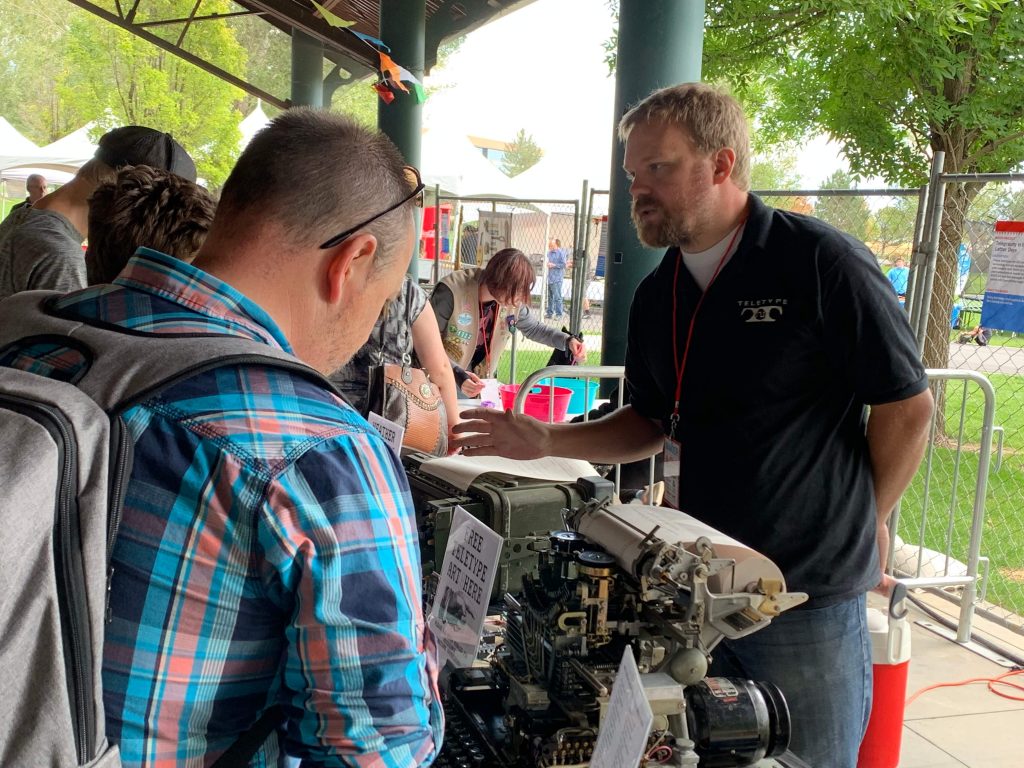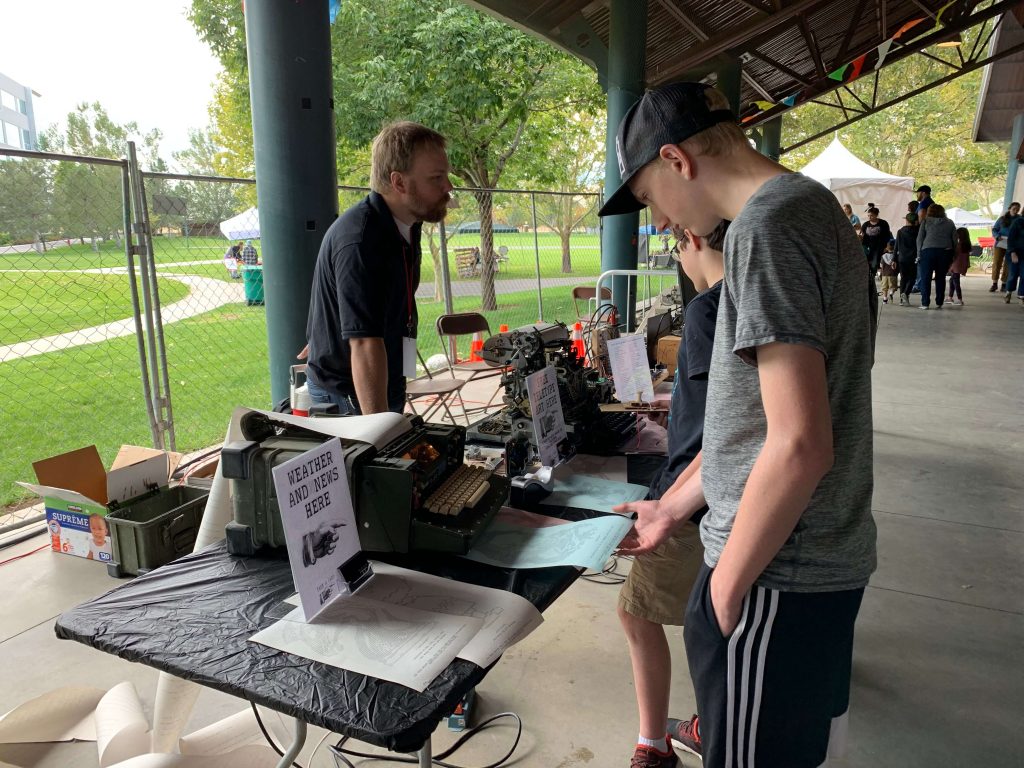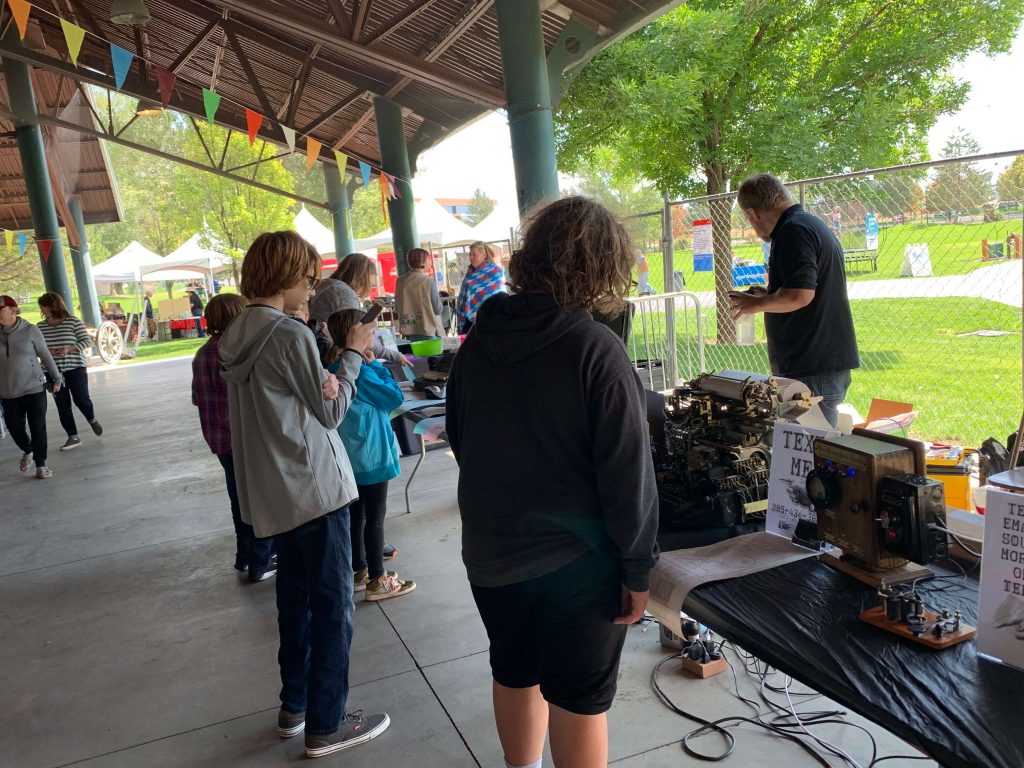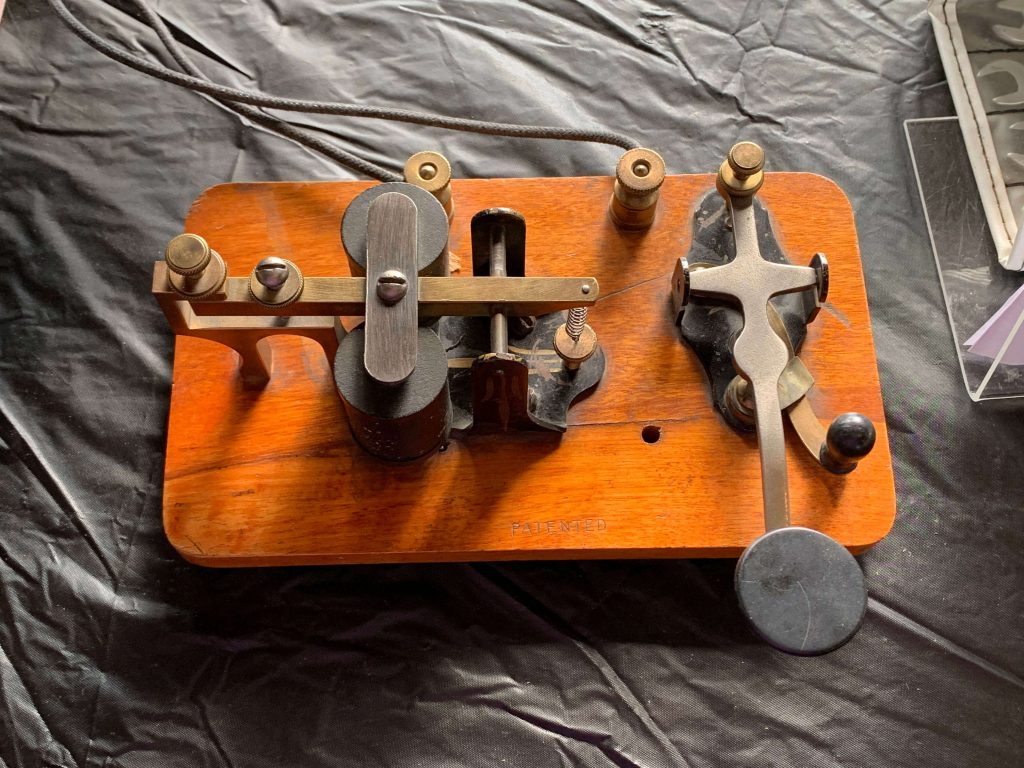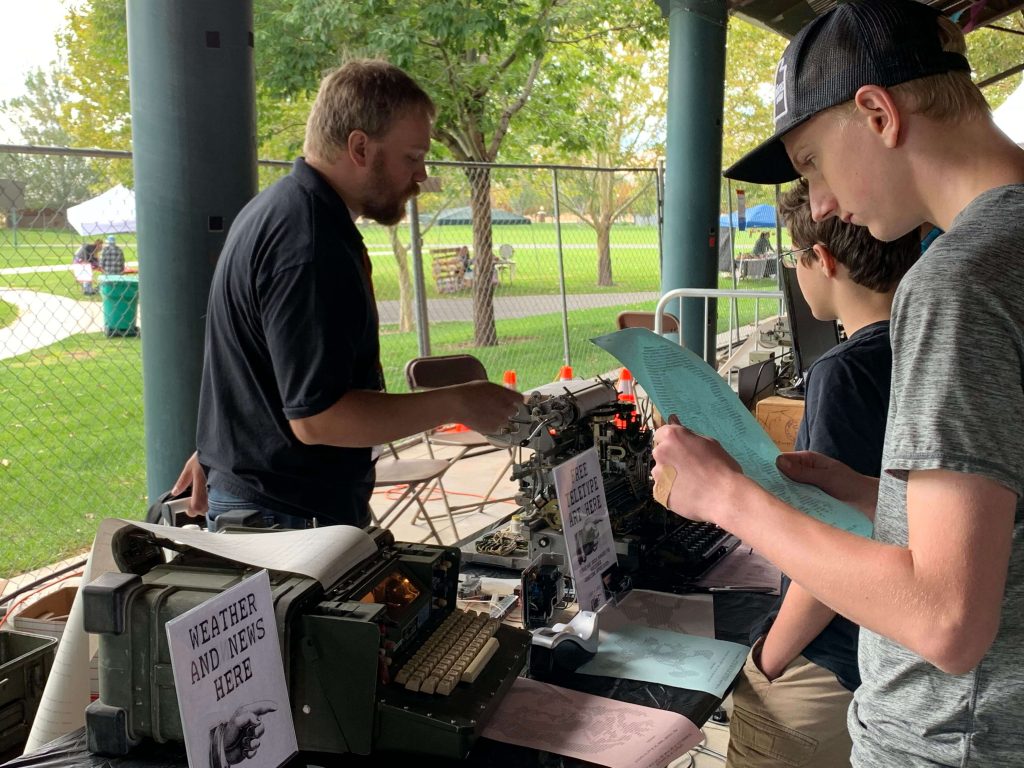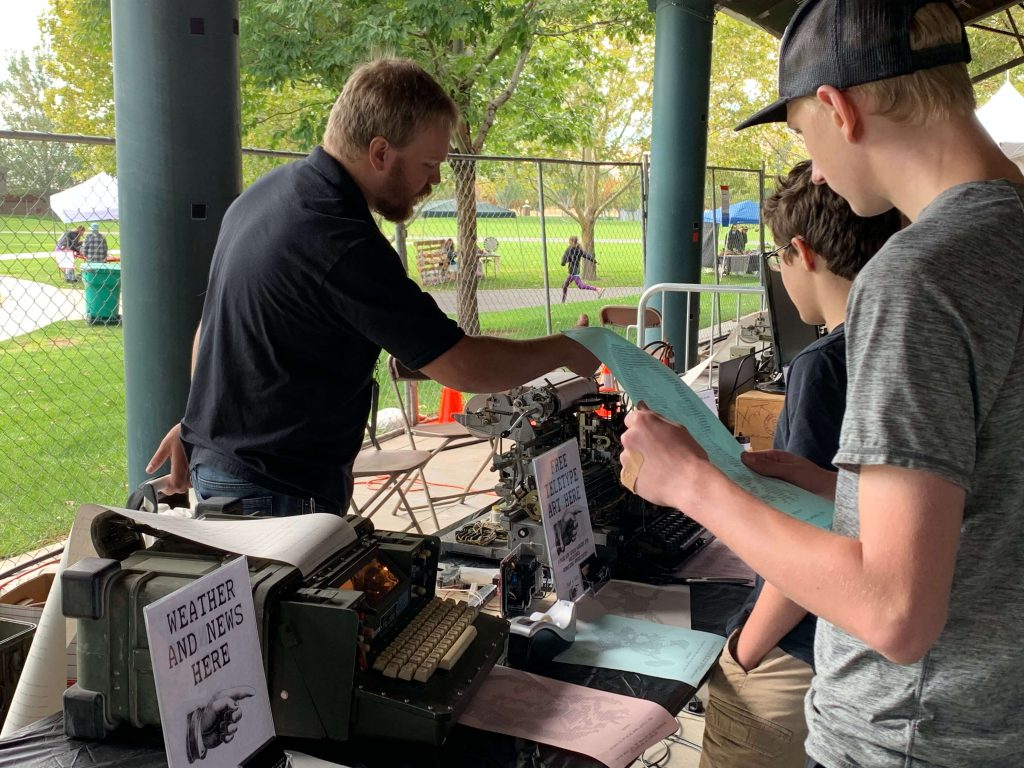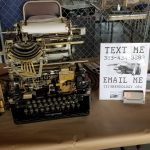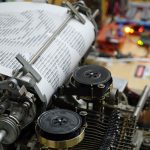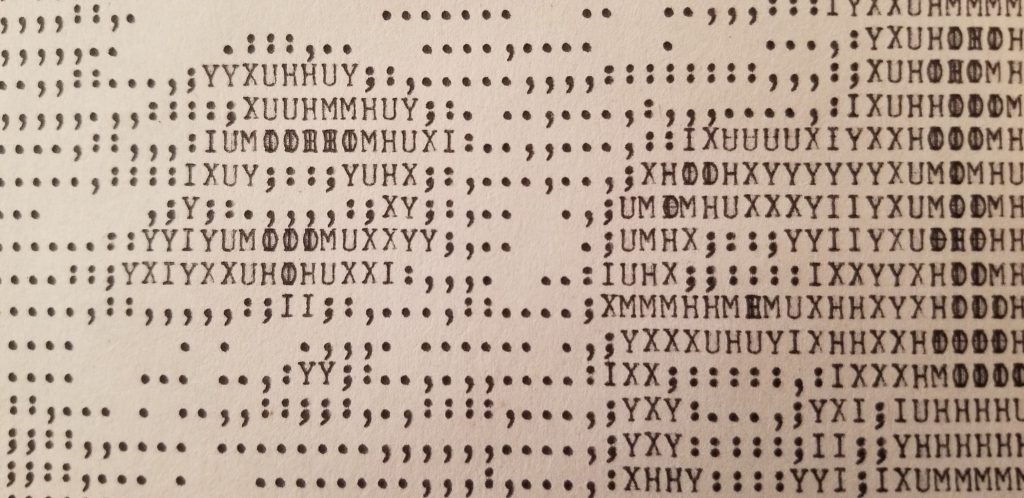Another year, another Faire.
Transmotive Improvements
This year I realized that I’m in the teletype game for the long haul, so I decided to purchase a small trailer from a retiring handyman to help me haul these around. It’s roughly 4 feet wide by 6 feet long by 5 feet tall, though some of that space gets eaten up by some wood framing on the inside. It’s got an outer shell made mostly of steel and is thus basically impenetrable by thieves, indicated by one of the doors that was clearly bent by crowbar in a vain attempt to gain entry. Unfortunately it is not thoroughly weather tight mainly due to the rear doors having no seals and one of them being bent a bit, but it protects the machines even in rain well enough, and I wrap the machines in padding to keep them from slipping and bumping into each other anyway. I wouldn’t want to go on long trips in bad weather, though.
I used this little old trailer to haul my machines to the fairpark, which made it much, much easier than trying to safely cram them all in the back of the Jeep as in times past.
I also purchased a nice cart that folds down to roll on four wheels that saved my back moving equipment to and from the pavilion.
Preparations
For days leading up to the event I printed out the most TTY art I have ever done as illustrated in the video below. I was finally able to keep up with demand without running out of art; I believe I had three or four pieces left over by the end of the day.
Some time prior to this I was still working pretty heavily on fulfilling the many orders I received for the USB to teletype interface boards I had manufactured. In the video below you will find Remington, one of our finest QA engineers, putting USB TTY Interface board no. 23 through its paces while Aveson, product manager, carefully inspects and ensures the tests are processed in accordance with all industry standards.
I ended up using one of these manufactured boards to drive the AN/UGC-74B on a brand new board I built literally 15 hours before the Faire. It was a simple build– just a piece of wood with the USB board, a power supply, some terminal blocks, a current limiting resistor, some fuses, and a power switch mounted to it. But it did the job perfectly:
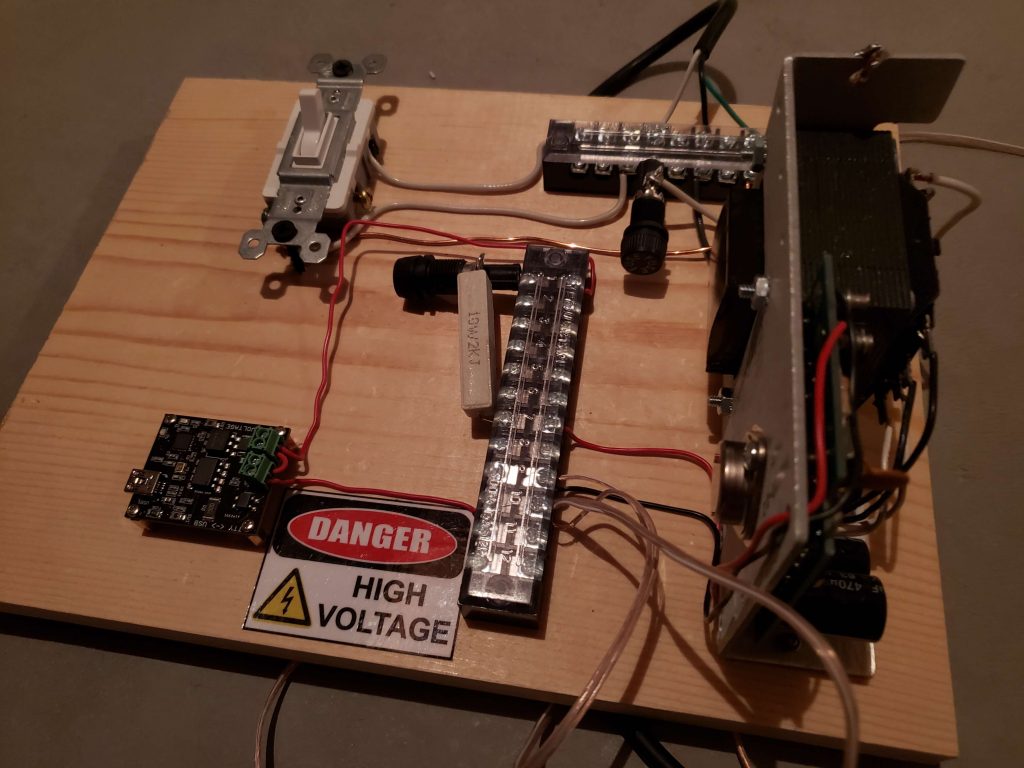
The manufactured boards are functionally the same as the two prototype boards I originally built and have been using for some time to drive my machines. They are much smaller and prettier, however.
Tangent: After the faire I noticed my first prototype board had some issues. At first I thought it was a mechanical problem with the teletype connected to it, but after swapping machines around and doing some deep sleuthing at the hardware level, I discovered that while the board was sending signals on the loop perfectly, it was not receiving signals well– text would get garbled or get eaten entirely even if the teletype on the loop printed it perfectly. I suspected a bad optoisolator and switched the receiving one out (good thinking for me to use sockets instead of soldering directly, eh?), but that did not resolve the problem. So I have since removed the original prototype from the array and replaced it with a manufactured board as I don’t have time to try and troubleshoot further.
Further tangent: Indeed, the plan is to do away with my original setup done on a simple wooden plank and build a custom enclosure complete with era-compatible telephone toggle switches, various meters, indicator lights, and six of these manufactured USB boards to drive up to six current loops at once. I’ve sourced almost all of the hardware– the time is now to build the enclosure, but that is a story for another day.
Network Upgrade
One of the improvements this round was the addition of a mobile router capable of tethering with a typical smartphone’s cellular connection. I received this as a gift from my favorite mother-in-law, and it is one of the best little gadgets I have ever used for these projects.
I did a bit of configuring beforehand to set up the subnet to mirror the one the Pis are configured to have a static IP address upon. This way there is no network configuration change required to move the Raspberry Pis between their regular network and the mobile network. It also makes sharing internet from the cellular connection much easier; previously I had to take many complicated network configuration steps I programmed into a bash script and executed on the main Pi before a faire in order to share the connection to other machines whilst tethering the phone to just the Pi. Now all I have to do is plug a phone into the router via USB, tether the phone to the router, and plug the Pis and my lappy in via ethernet, and everything works flawlessly. I also use a 5-port switch, of course, as the router has only a single LAN Ethernet port.
The mobile router, for those curious, is this handy little gadget, available for a nominal sum at the monolithic Amazon.
At the Faire
Unfortunately I got there a bit late, and I’ve learned that my entire setup takes about an hour to set up and take down:
- Model 19 printing received SMS messages
- Model 15 printing art (RTTY/ITA2/USTTY art or whatever technical term you wish– I usually refer to it as ASCII art to laymen since that’s the term that most will know even though it’s technically incorrect in this context; this is in spite of the fact that even kids these days rarely have heard of ASCII)
- AN/UGC-74B printing news and local weather feeds
- L.E. Knott Apparatus Co. telegraph sounding the SMS messages sent to the Model 19 in American Morse Code whilst the message is printed on the Model 19
- The custom controllers I created built on Raspberry Pis to drive all the machines
- A monitor to display logs
- A lappy to drive the monitor
- Signs to indicate what the machines are and how to interact with them, which seems to mostly be in vain since I have to wear my voice out telling passers by what’s on the signs even though the signs are in their faces (I am probably going to invest in bigger signs)
- Behind the scenes mobile networking to allow SMS, weather, and RSS retrieval
So a few early birds missed the booth, but alas. Nothing could be done.
Overall, the faire seemed much smaller than Thanksgiving Point’s first faire in 2018. I’m not sure why that was– perhaps marketing wasn’t pushed as much this time, perhaps people thought they didn’t need to see it again since they came once before. I am not aware of any major competing events that occurred that weekend. I do know that the big YouTuber they had last year– King of Random— was not present as he had sadly passed on to That Next Place earlier in the year. I’m sure he had attracted a lot of visitors the first year, and I was not aware of any extremely big names like his for the 2019 faire.
Still, there were plenty enough people to keep the machines fairly busy throughout the day.
Throughout the day I was able to make contact with other inventors, artists, and so forth, most notably the fellow who built exact copies of revolutionary war canons who I found out lives just a few streets away from our new house, the group that runs large scale ridable model trains, and the Utah Steampunk Society dressed in appropriate garb, taking pictures next to my machines that fit pretty well in their fantasy. Indeed, someday I may try and bring my machines to one of their events.
One fellow who was building model cars and environments to put them in offered me his old dot matrix printer. I reached out to take him up on it, but I’ve not heard back yet. While a more distant relative, the dot matrix printer is still a relative of the teleprinter, and I would love to add one to my growing collection and give it a good home where it will be used and loved.
My wife does not necessarily share that sentiment, but she is incredibly supportive of this insane obsession.
Photographic Evidence
I neglected taking any photos this time, but I did source these from paparazzi.
Stage Presentation
A week or so before the faire, I received a message from the organizer asking if anyone would be interested in filling in a 30-minute gap on the stage.
I raised my hand, was chosen, and put together a presentation that, considering I finished and practiced for the first time at 2:30 AM the morning of the Faire, I thought went pretty well. I had the foresight to bring some equipment to record the faire, and I’ve edited it together for your viewing pleasure below.
For those of you who are pedants, savants, or otherwise insane hairsplitters such as myself, I feel the need to point out that I had to cram both a sesquicentury-long history lesson and a technology demonstration into a 30-minute time period whilst making it interesting for the layman who’d never heard of any of it before, so I had to take many liberties in simplifying the information that was shared. The presentation covers a mere drop in the bucket of what could have been shared had I hours to share it and days to prepare it. So calm down and enjoy it for what it is.
Aside from my own family (one of whom fell asleep), there were only 5 people who attended the presentation. One of them was the emcee who couldn’t care less what I was talking about, one of them came halfway through and left two minutes later, and the remaining three had already been to my booth.
It was a big hit.
Actually, one of the problems this year was that the presentation pavilion was far away from the rest of the faire, so I think many people didn’t even realize it was there. Last year the stage was on one side of the main pavilion where all the booths were. It did make things even louder than with just my machines chattering away, but it seemed like the presentations did better that way.
I briefly considered bringing one of the machines up for a live demonstration, but it would have been ill advised to haul one of those machines the hundred or so yards to the stage and attempt to set it up quickly enough.
Until Next Time
The Faire was a great success in spite of what seemed like fewer attendees and a largely forgotten teletype presentation.
I loaded everything back into the trusty trailer and went…

